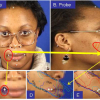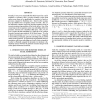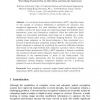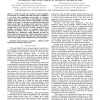814 search results - page 56 / 163 » Face Recognition Algorithms as Models of Human Face Processi... |
148
click to vote
CVPR
2009
IEEE
16 years 5 months ago
2009
IEEE
Contemporary face recognition algorithms rely on precise
localization of keypoints (corner of eye, nose etc.). Unfortunately,
finding keypoints reliably and accurately remains
a...
110
click to vote
ICIP
2005
IEEE
15 years 11 months ago
2005
IEEE
Recently, it was proven empirically that facial expressions can be modelled as isometries, that is, geodesic distances on the facial surface were shown to be significantly less se...
101
click to vote
ACCV
2007
Springer
15 years 4 months ago
2007
Springer
A novel kernel discriminant transformation (KDT) algorithm based on the concept of canonical differences is presented for automatic face recognition applications. For each individu...
88
Voted
IROS
2006
IEEE
15 years 4 months ago
2006
IEEE
— In the last decade, face analysis, e.g. face recognition, face detection, face tracking and facial expression recognition, is a very lively and expanding research field. As com...
FGR
2011
IEEE
14 years 1 months ago
2011
IEEE
— Many modern computer vision algorithms are built atop of a set of low-level feature operators (such as SIFT [1], [2]; HOG [3], [4]; or LBP [5], [6]) that transform raw pixel va...




